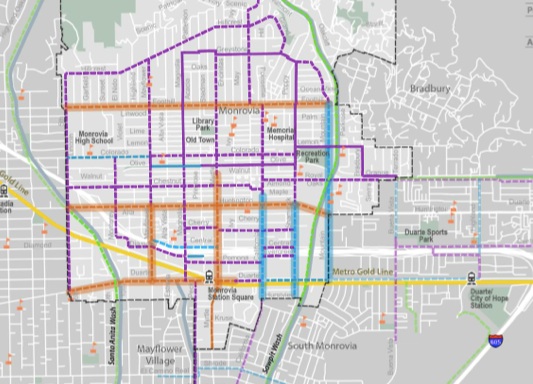Monrovia’s Bike Plan
Tuesday night, toward the end of a loooooong Monrovia City Council meeting, agenda item AR-4: “Monrovia Bicycle Master Plan” finally came before the Council. After a brief summary of the proposed bike master plan by the city’s public works manager, Sean Sullivan, the floor was opened for comments. I had hoped there wouldn’t be too much NIMBY opposition to the plan’s proposed bike lanes and in fact all the public comments were positive. A number of members of “Move Monrovia,” the local bike advocacy group, attended and spoke in support of the plan. Monrovia cyclist Robert Lewis, for example, eloquently discussed the need for better bike infrastructure in town. “The fact is, people like me will ride regardless,” he told the Mayor and Councilmembers. “What we need to do is lower the barriers for the rest of the community to ride to the grocery store once a week or to leave their car at home and ride with their children to Monroe Elementary once a week.” After several other speakers praised the plan, the council members voted unanimously to adopt the new bike plan. After such a long struggle to get this plan going, there is a tremendous sense of achievement.
The new plan, drafted by Alta Planning, is a huge step for this community. It addresses a number of critical transportation issues in Monrovia. It extends Class II bike lanes to Monrovia High School and along Chestnut in the western half of the city, as well as Central Ave between Mayflower and Myrtle and Duarte Ave between Montain and California. Existing bike lanes on Olive Ave. by Monroe Elementary will be upgraded to buffered bike lanes, offering added protection for students and their families. The plan also proposes more bike racks and end of trip facilities (such as repair and hydration stations) and promotes bike safety education programs and community rides as a way of encouraging a shift away from the automobile monoculture. In all, there is much to like about this plan.
I do have some concerns, however. First, the plan relies heavily on Class III “bicycle routes” which may or may not mean anything more than sharrows and increased signage. This is especially the case on the area around the new Gold Line station on Mayflower, California, and Pomona streets. If the city makes these “bike routes” real neighborhood greenways, with infrastructure designed to lower speeds and divert cars to other streets, then it will be an major improvement and encourage the “interested but concerned” majority to venture out on their bikes. Otherwise, the improvement will be negligible.
On a number of important streets the plan recommends only “study” of either Class II bike lanes or Class IV separated bike lanes, but no timetable for study, let alone implementation. On a number of these streets, the only way to fit bike lanes would be to remove on-street parking or a “road diet.” Indeed, a number of city officials have remarked about the city’s “narrow” streets being a barrier to bike infrastructure. I fear that, instead of seeing the streets of this old streetcar suburb as perfect for a rethinking of the primacy of the automobile, the needs of people on foot and on bikes will be sacrificed to the continued domination of the most inefficient transportation mode–cars. In other words, the plan puts off the hard choices for a later date (which may be why there was no opposition at the Council meeting). As we learned in Temple City recently, once you start asking motorists to park a little further away, or take 30 seconds longer to get through town, they will scream bloody murder. Inconvenience them just a little, call into question their God-given right to drive everywhere and park wherever they want and they’re ready to string up those awful bikers.
In sum, Monrovia has taken an important step toward the creation of a city grid that works for all road users. The task of organizing and lobbying remains, however, and the hard work of growing and mobilizing a constituency for more ambitious transformation must also commence in earnest. Fortunately, the advocates are in place, and have a victory under their belt.

Pingback: Morning Links: Metro Bike kickoff in DTLA, bike-friendly Amoeba, and even Trump can’t stop the Rump |
I just discovered this article from last year–as someone who grew up in Monrovia and rode the Red Cars, I noticed that one of the routes is on Olive Ave. Back in 1952, when I was a student at Monroe School, I saw the Pacific Electric rails ripped out of Olive Ave. after passenger service quit in 1951. And a few blocks south is Chestnut Ave., which was occupied by a PE freight line until 1961. I lived on 5th Ave., which is also part of the Bike Plan. It’s good to see that my old home town is getting the message, along with celebrating the return of electric passenger railway service in the Gold Line.